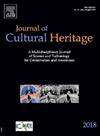Boosting the consolidation and antibacterial dual-functionalities of Ca(OH)2 mural restoration materials via supporting Ag/g-C3N4 on hexagonal nano-Ca(OH)2
IF 3.5
2区 综合性期刊
0 ARCHAEOLOGY
引用次数: 0
Abstract
Ca(OH)2 is a well-known commercial inorganic consolidation material, which is used to restore tomb murals. Herein, nano-Ca(OH)2 with a high specific surface grown by molecular confinement method was supported with photocatalyst Ag/g-C3N4 to form a highly permeable Ag/g-C3N4/Ca(OH)2, which achieved consolidation and antibacterial properties of simulated murals. Ag/g-C3N4/Ca(OH)2 forms a unique gradient permeation structure on tomb murals. In this structure, the Ca(OH)2 nanomaterial penetrates deeply, while the Ag/g-C3N4-rich layers remain on the mural surfaces. The Ag/g-C3N4-rich layer effectively protects the murals from bacteria. The results indicate that the Ag/g-C3N4/Ca(OH)2 nanocomposite significantly enhances the mural's strength and antibacterial properties when the silver ion doping content is 0.24. Its strengthening performance is 2 times higher than commercial Ca(OH)2, while its antibacterial rate reaches 58.38 %, primarily due to its high permeability and stability. Further aging experiments indicate that the synthesized Ag0.24/g-C3N4/Ca(OH)2 nanocomposite has no adverse effect on the mural's pigment layer. This work offers a new method for developing effective materials to protect tomb murals.
Ag/g-C3N4在六方纳米Ca(OH)2上的负载,增强Ca(OH)2壁面修复材料的固结和抗菌双功能
Ca(OH)2是一种众所周知的商业无机固结材料,用于修复墓葬壁画。本文采用分子约束法生长出具有高比表面的纳米Ca(OH)2,用光催化剂Ag/g-C3N4负载形成高渗透性的Ag/g-C3N4/Ca(OH)2,实现了模拟壁画的固结和抗菌性能。Ag/g-C3N4/Ca(OH)2在墓葬壁画上形成独特的梯度渗透结构。在这种结构中,Ca(OH)2纳米材料深入渗透,而Ag/g- c3n4富层保留在壁面上。富含Ag/g- c3n4的层有效地保护了壁画免受细菌的侵害。结果表明,当银离子掺杂量为0.24时,Ag/g-C3N4/Ca(OH)2纳米复合材料显著提高了壁面的强度和抗菌性能。其强化性能是商品Ca(OH)2的2倍,抑菌率达到58.38%,这主要得益于其高渗透性和稳定性。进一步老化实验表明,合成的Ag0.24/g-C3N4/Ca(OH)2纳米复合材料对壁画颜料层无不利影响。这项工作为开发有效的墓葬壁画保护材料提供了新的途径。
本文章由计算机程序翻译,如有差异,请以英文原文为准。
求助全文
约1分钟内获得全文
求助全文
来源期刊

Journal of Cultural Heritage
综合性期刊-材料科学:综合
CiteScore
6.80
自引率
9.70%
发文量
166
审稿时长
52 days
期刊介绍:
The Journal of Cultural Heritage publishes original papers which comprise previously unpublished data and present innovative methods concerning all aspects of science and technology of cultural heritage as well as interpretation and theoretical issues related to preservation.
 求助内容:
求助内容: 应助结果提醒方式:
应助结果提醒方式:


